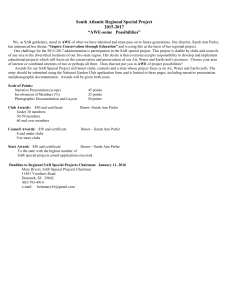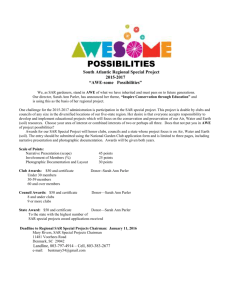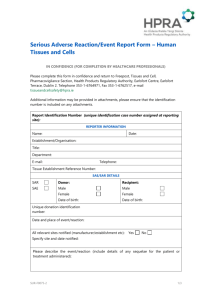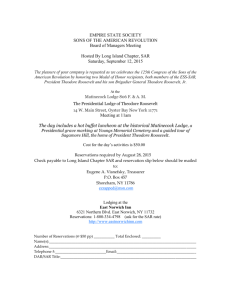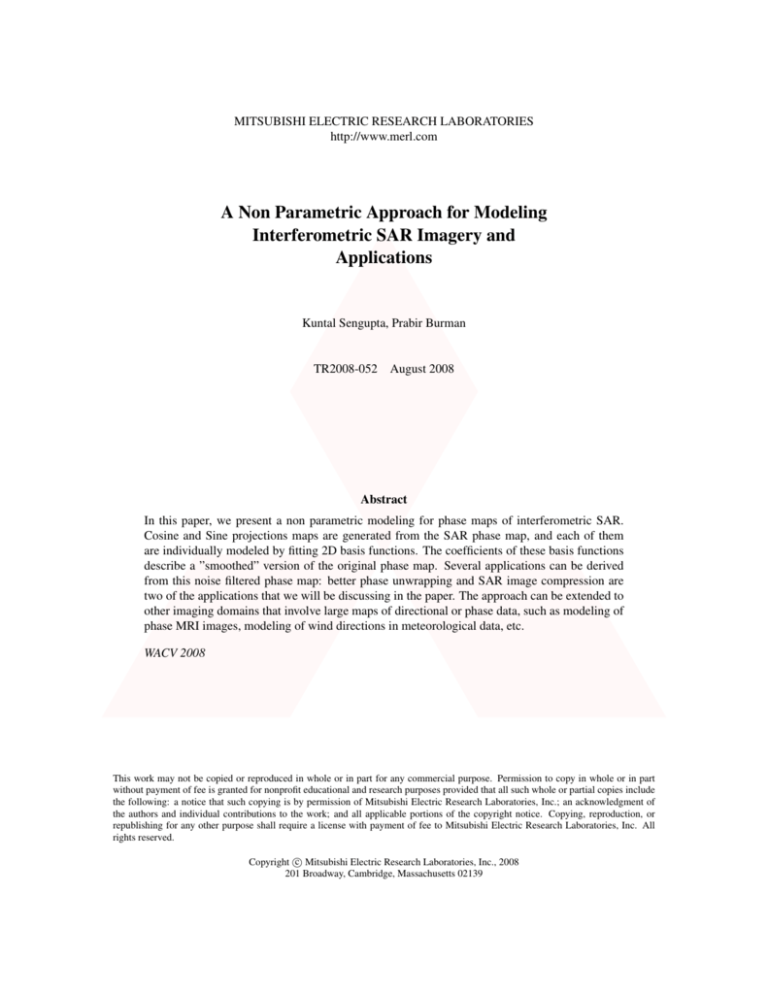
MITSUBISHI ELECTRIC RESEARCH LABORATORIES
http://www.merl.com
A Non Parametric Approach for Modeling
Interferometric SAR Imagery and
Applications
Kuntal Sengupta, Prabir Burman
TR2008-052
August 2008
Abstract
In this paper, we present a non parametric modeling for phase maps of interferometric SAR.
Cosine and Sine projections maps are generated from the SAR phase map, and each of them
are individually modeled by fitting 2D basis functions. The coefficients of these basis functions
describe a ”smoothed” version of the original phase map. Several applications can be derived
from this noise filtered phase map: better phase unwrapping and SAR image compression are
two of the applications that we will be discussing in the paper. The approach can be extended to
other imaging domains that involve large maps of directional or phase data, such as modeling of
phase MRI images, modeling of wind directions in meteorological data, etc.
WACV 2008
This work may not be copied or reproduced in whole or in part for any commercial purpose. Permission to copy in whole or in part
without payment of fee is granted for nonprofit educational and research purposes provided that all such whole or partial copies include
the following: a notice that such copying is by permission of Mitsubishi Electric Research Laboratories, Inc.; an acknowledgment of
the authors and individual contributions to the work; and all applicable portions of the copyright notice. Copying, reproduction, or
republishing for any other purpose shall require a license with payment of fee to Mitsubishi Electric Research Laboratories, Inc. All
rights reserved.
c Mitsubishi Electric Research Laboratories, Inc., 2008
Copyright 201 Broadway, Cambridge, Massachusetts 02139
MERLCoverPageSide2
A non parametric approach for modeling interferometric SAR imagery and
applications
Kuntal Sengupta
MERL
sengupta@merl.com
Abstract
In this paper, we present a non parametric modeling
for phase maps of interferometric SAR. Cosine and
Sine projections maps are generated from the SAR
phase map, and each of them are individually
modeled by fitting 2D basis functions. The
coefficients of these basis functions describe a
"smoothed" version of the original phase map.
Several applications can be derived from this noise
filtered phase map: better phase unwrapping and
SAR image compression are to of the applications
that we will be discussing in the paper. The approach
can be extended to other imaging domains that
involve large maps of directional or phase data, such
as modeling of phase MRI images, modeling of
wind directions in meteorological data, etc.
1. Introduction
Synthetic aperture radar (SAR) involves imaging of
the Earth by processing microwave backscattering
data collected along the flight path of an aircraft or a
spacecraft [1-2]. The data collection leads to highresolution images of the local complex ground
reflectivity. Starting from two SAR images obtained
from different flight paths, these images are first
registered and a product image is computed by
multiplying the first image with the complex
conjugate of the second image. The phase of the
product image is the SAR interferogram. Note that
the phase is limited between -π and π. The inherent
circular nature of the data leads to the “artificial”
discontinuities in the map. This “wrapped” phase
map needs to be processed further.
Unwrapping the phase map leads to digital elevation
model of the terrain [3]. Unwrapping involves the
removal of the phase hops of more than π between
neighboring pixels, by adding or subtracting
multiples of 2π. The assumption here is that the
underlying function is a smooth function. However,
in practical situations, the 2D phase is corrupted by
noise. For example, temporal and baseline
decorrelation introduces local inconsistencies
Prabir Burman
UC Davis
pburman@ucdavis.edu
in the data called the residues. 2D phase
unwrapping algorithms are highly sensitive to
residues, especially if these residues introduce
local singularities in the map [4]. For example,
given a pixel, if we walk around its eight
neighbors, with this pixel in the center, the angle
values should sum up to approximately zero. If the
sum is close to a non zero multiple of π, this
implies that the data has a singularity, and the map
cannot be unwrapped. This fact is used widely in
the fingerprint literature to find cores and deltas in
the orientation field computed from the fingerprint
image. Formally, this is called as the Poincare
index method in locating feature points in
fingerprint images [5].
Having noted that the noise sensitivity of 2D phase
unwrapping algorithms is a critical factor in
obtaining the digital elevation map, we need to
devise techniques for noise filtering, or smoothing
of the data. Most techniques reported in the
literature treat the problem as an image denoising
problem, and design filters to address the issue.
One other application domain that we wish to
address here is the compression of angle maps. By
using a non parametric model fitting approach, we
address both the problems of smoothing 2D phase
maps as well as compression. There are two main
contributions of the paper:
- we present an unique model based
smooth representation of SAR phase maps
- we present a method of filtering noisy
SAR phase maps.
To our knowledge, not much prior literature exists
in the area of modeling/coding of 2D phase maps.
The phase image datasets are often treated like
normal intensity images, and compression
algorithms such as wavelets or DCT are used. Our
non parametric approach is an extension of our
prior work in [7], and the algorithm/code
developed there has been applied to solve this
problem. Outside the domain of SAR imagery,
there are several other applications where
compression of large databases of angle maps are
considered important. Three dimensional phase
MRI, meteorological data with wind direction are a
few of these examples.
2. A Non Parametric Approach to Estimating
the Phase Map Model in 1D
A phase map can be fully represented by a discrete
matrix whose elements represent the direction
pointed to by a hypothetical vector planted at the
corresponding pixel. To avoid the difficult problem
created by orientation discontinuity, we create two
distinct maps, the cosine and the sine map of the
phase [7]. At the location (i,j), if the phase value is
Θ(i,j), then define the two maps S and C as follows:
S(i,j) = cos(Θ(i,j)) and
C(i,j) = sin(Θ(i,j)).
(1)
(2)
In the equation above, Z is the underlying (true)
curve, and ε is the noise at the location xi,
respectively. Assume i = 1, 2, ..n. Following [7], we
model the underlying curve as a summation of basis
splines as shown below:
Z ( xi ) = ψ T ( xi )θ.
(3)
Here, ψ(xi,) is the a vector of basis function values at
the location xi. For example, if we consider m basis
functions, then ψ is m×1. Also, θ is the weight
associated with each basis function, and its
dimension is 1×m.
For a chosen set of basis functions, and our
observation values S(xi), we need to estimate the
weights associated with these functions. For these,
we use the Minimum Mean Squared approach. The
cost function defined is:
Q(θ ) =
and
B=
1
∑ ψ(xi )ψ T (xi )
n i
1
∑ S ( xi )ψ T ( xi ).
n i
(4)
Note that A is a m×m matrix, and B is m×1 matrix.
Next, we compute the eigenvector as follow:
Γ = EIGEN _ VECTOR (BA −1B T ). (5)
The eigenvector considered above is the one that is
associated with the largest eigenvalue. The
estimated weight matrix is computed as:
θˆ = A −1 B T Γ.
For ease of explanation, we would consider the
discussion on the 1D case initially. For the sine
curve (map), the noise model is:
S ( xi ) = Z ( xi ) + ε ( xi ).
A=
2
1
(
S ( xi ) − ψ T ( xi )θ ) .
∑
n i
To solve the above equation for the weight
parameters, we construct two matrices as follows:
The smooth sine projection of the phase map is:
)
)
S ( x) = θ • ψ ( x ).
The above process is repeated for the cosine map
too, and similar weights of the spline function are
determined.
3. Choosing the Basis Functions and extension
to 2D
Inspired by the Fourier Expansion work on
fingerprint orientation map in [6], we choose
(2K+1) the basis functions as below:
1/ 2 i = 0
ψ ( x ) = cos mνx i = 2m − 1; m = 1,2,.., K
sin mνx i = 2m; m = 1,2,..., K
In the above equation, ν = π/n. One nice property
to note is that the basis functions are orthogonal,
hence A is a diagonal matrix. This makes the
inversion function computation in Eq. [5] very
trivial while computing the weight function. Other
basis functions such as basis spline functions can
be considered too, but for the computational
efficiency, one can orthogonalize the basis set
using the QR factorization technique.
Thus, if we have 2(2Kx+1)(2Ky+1) coefficients
modeling the cosine and the sine maps, the total
storage requirements are 2N(2Kx+1)(2Ky+1).
Once these coefficients are known, the estimated
cosine and sine maps are computed and the
original phase map are estimated. The estimated
phase map is smooth, and the error map is
computed by subtracting the original map from the
estimated map. The subtraction has to consider the
wrap around issue. Keeping the circular nature
data in mind, one can generate the error map,
which is always bounded between – π and π. This
map can be further compressed using a standard
compression technique, such as DCT based
method or wavelet based methods. Since the
dynamic range of the error map is generally low, a
fewer number of bytes can easily code this map.
The model based technique coupled with the error
map helps us in achieving high compression ratio.
Also, the resulting estimated phase map using the
dual strategy is noise filtered and can be
unwrapped effectively.
Phase
Figure 1: Plot of a few sample orthogonal 1D basis
functions selected for the experiments here (top),
and a mesh plot of the 2D basis function (bottom).
The extension of the technique described in Section
2 is straightforward. We now consider the tensor
product of the basis functions in dimension x and
dimension y. The rest of the mathematics is almost
similar, with the difference that we have nx ×ny
observations to deal with.Also, assuming that there
are (2Kx+1) 1D functions for the x dimension and
(2Ky+1) 1D functions for the y dimension, the
weight vector has (2Kx+1)(2Ky+1) elements or
coefficients in it. A few example 1D and 2D basis
functions are illustrated in Figure 1.
Cosine
Map
Sine
Map
Function
Fitting
Function
Fitting
Quantize
Quantize
θc1, θc2, θc3.
4. Representation of the map: Quantization and
Error Map
As shown in Figure 2, the (2Kx+1)(2Ky+1)
coefficients of the basis functions corresponding to
the estimated sine and the cosine maps, respectively,
essentially code the phase map. Each of these
coefficients are quantized and coded in “N” bits.
θs1, θs2, θs3.
Figure 2: The model fitting approach for angle
maps.
θc1, θc2, θc3..
Estimate Cosine
Map
Smoothed Phase
Map
θs1, θs2, θs3..
(from raw SAR data) is quite apparent in the
image.
Estimate Sine
Map
Original Phase
Map
Compress
Diff Map
Figure 3: Generation of the difference map while
considering the circular nature of the data.
Figure 4: An example input phase map (note
that the value of the phase has been quantized
between 0 and 255).
5. Experimental Results: Compression
We obtained interferometric SAR images from the
STAR Lab of Stanford University. The SAR image
corresponded to an area around Mt. Etna. The phase
map is computed from the raw SAR imagery using
the software package (“snaphu”)[8].
To perform our experiments, we divided the region
into several blocks of 128x128 pixels. For each such
block, we modeled the phase map using the non
parametric method described in Section 2 of this
paper. For our experiments, we used a total of 121
(11 functions in each dimension) 2D basis functions.
The 242 coefficients obtained were coded using 1
byte each. The error map generated was coded using
a standard DCT coding scheme, where each of the
128x128 blocks were subdivided into 8x8 blocks for
DCT computation and coding. For a given byte
allocation for the entire 128x128 block, whatever
budget is left after using up the quota for the 242
(model) coefficients were used to code the DCT
coefficients. In Figure 4, we illustrate one such patch
of the SAR phase image. For illustration purposes,
the phase value between 0 and 2π is quantized
between 0 and 255. The noise in the computed phase
Figure 5: The modeled phase map.
Figure 6: The error in the phase map modeling,
which is coded using conventional means.
6. Experimental Results: Unwrapping
One of the purposes of smoothing the phase data
using the non parametric technique is to aid the
unwrapping functionality for digital elevation
model computation. We unwrapped the model
map (using a simplistic algorithm which is not
described within the scope of this work) in Figure
5 and obtained a continuous map illustrated in
Figure 8. The unwrapping of the phase map
obtained by adding the model phase to the DCT
compressed error also has the nice properties of
continuity (Figure 9). However, the original map
is not continuous, while unwrapped, ash shown in
Figure 10.
Figure 7: The (model phase + decoded error
map), which is obtained finally by the codingdecoding process. For this example, the overall
compression ratio was set to 2:1.
In Figure 5, we illustrate the smoothed model
obtained using our technique, while Figure 6
illustrates the error map coded by the DCT
technique. Figure 7 illustrates the model phase map
added to the decoded error map.
To obtain an idea of the power of the non parametric
technique, we computed the mean of the absolute
error between the overall decoded map and the
original phase map. We compared this with the
conventional SCT compression technique, for the
same overall byte allocation. The experiment is
repeated over two compression ratios, 2:1 and 4:1.
We report the results in Table 1. Note that the model
based method for 4:1 ratio even outperforms the
conventional method at 2:1 compression ratio.
Table 1: Table illustrating the mean absolute
error (in radians) at each pixel location using the
model based method described in the paper and
the conventional method of compression.
2:1
4:1
Model based
0.123
0.156
Conventional
0.276
0.346
Figure 8: Unwrapping of the modeled phase
map (note that 256 represents 2π
π).
Figure 9: Unwrapping of the (modeled phase map
+decoded error map).
Images as a Fuzzy Matching-Pursuit Blind
Estimation, “JASP(2005), No. 20, 2005, pp. 32203230.
[5] D. Maltoni, D. Maio, A.K. Jain, S. Prabhakar,
Handbook of Fingerprint Recognition
Springer, Chapter 3, New York, 2003
[6] W. Ying, J. Hu and D. Phillips, “A Fingerprint
Orientation Model Based on 2D Fourier
Expansion (FOMFE) and Its Application to
Singular-Point
Detection
and
Fingerprint
Indexing, “ IEEE Trans. Pattern Analysis and
Machine Intelligence, vol. 29, no. 4, pp. 573-585,
April 2007.
Figure 10: Unwrapping of the original map
(shows discontinuities).
[7] K. Sengupta and P. Burman, “A Curve fitting
Problem and Its Application in Modeling Objects
from Images,” IEEE Trans. Pattern Analysis and
Machine Intelligence, vol. 24, no. 5, pp. 674-686,
2002.
[8] www-star.stanford.edu/sar_group/snaphu/
7. Conclusions
In this paper, we presented a model based technique
for representing SAR phase images. The method can
be used for filtering noise to aid unwrapping, as well
as SAR image compression. This technique can be
applied in all computer vision applications that
involves modeling and analysis of vector fields.
References
[1] G. Franceschetti and G. Fornaro, “SAR
interferometry,” in Synthetic Aperture Radar
Processing, G. Franceschetti and R. Lanari, Eds.,
chapter 4, pp. 167–223, CRC Press, New York, NY,
USA, 1999.
[2] P. A. Rosen, S. Hensley, I. R. Joughin, et al.,
“Synthetic aperture radar interferometry,” Proc.
IEEE, vol. 88, no. 3, pp. 333–382, 2000.
[3] R. M. Goldstein, H. A. Zebker, and C. L.
Werner, “Satellite radar interferometry: twodimensional phase unwrapping,” Radio Science, vol.
23, no. 4, pp. 713–720, 1988.
[4] B. Aiazzi, S. Baronti, M. Bianchini, A. Mori, L.
Alparone, “Filtering of Interferometric SAR Phase




